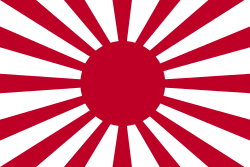Prince Kitashirakawa Yoshihisa
Prince Kitashirakawa Yoshihisa (北白川宮能久親王, Kitashirakawa-no-miya Yoshihisa-shinnō, 1 April 1847 – 27 October 1895) was a member of the Japanese imperial family, who served as the second head of a collateral branch. After his death, he was enshrined as the main and only deity in Tainan-Jinja, Taiwan, with the name Kitashirakawa no Miya Yoshihisa-shinnō no Mikoto.
Biography
Early life
Prince Kitashirakawa Yoshihisa was born as the ninth son of Prince Fushimi Kuniie (1802–1875) and Horiuchi Nobuko. He later became a Buddhist priest with the title Rinnoji-no-miya and served as the abbot of Kan'ei-ji in Edo.
Bakumatsu period
During the Boshin War, Prince Yoshihisa fled north with Tokugawa supporters after the Satsuma-Chōshū takeover of Edo. He became the nominal head of the "Northern Alliance" consisting of most of the domains of northern Japan, led by Date Yoshikuni of Sendai. Some documents refer to Prince Yoshihisa as "'Emperor Tōbu"' and describe the planned era names for his reign, but historians disagree on whether or not he was actually named emperor. His era name was believed to have been either Taisei or Enju depending on the source.
After the Meiji Restoration, in 1873, Emperor Meiji ordered all imperial princes serving as Buddhist priests to return to their secular status. Prince Kitashirakawa Yoshihisa, at that time serving as a priest under the title Rinnoji-no-miya, was also recalled to secular life. Later that year, he succeeded his younger brother, Prince Kitashirakawa Kasunari, as the second head of the new princely house of Kitashirakawa-no-miya.
Marriage and family
The couple had one son, Prince Morimasa (護正宮, Morimasa-no-miya, 25 September 1887 – 18 May 1949).
- Prince Kitashirakawa Naruhisa (18 April 1887 – 2 April 1923)[1]
Also, Prince Yoshihisa had five sons and five daughters by various concubines, as was common practice for the time:
- Prince Tsunehisa Takeda (22 September 1882 – 23 April 1919)
- Prince Nobuhisa (28 August 1885 – 28 June 1886)
- Countess Kanroji Mitsuko (19 October 1885 – 16 July 1975)
- Count Futara Yoshiaki (26 October 1886 – 18 April 1909)
- Countess Arima Sadako (6 August 1887 – 16 August 1964)
- Marquis Komatsu Teruhisa (2 August 1888 – 5 November 1970)
- Viscountess Hoshina Takeko (28 March 1890 – 18 March 1977)
- Count Ueno Masao (16 July 1890 – 16 February 1965)
- Princess Kotoko (20 December 1891 – 22 January 1892)
- Countess Futara Hiroko (28 May 1895 – 7 March 1990)
Military career

Prince Kitashirakawa Yoshihisa became a soldier and went to Germany to learn more about military training. He went back to Japan in 1887. He became a general and was put in charge of the 4th Division as a lieutenant general in 1893. The First Sino-Japanese War started in 1894 and he joined the Japanese attack on Taiwan. However, he caught a disease called malaria and died near Tainan. There were some rumors that he was killed by guerrillas in Taiwan.[2] Prince Kitashirakawa Yoshihisa was the first person from Japan's royal family to die in a war outside Japan. He died during the Japanese invasion of Taiwan in the First Sino-Japanese War of 1894-1895. After his death, he was given a special status as a kami in the State Shinto religion. Many Shinto shrines built in Taiwan during Japan's rule had his shrine, and he was also enshrined in Yasukuni Jinja.[3]
Honours
National
- Grand Cordon of the Order of the Rising Sun, 31 December 1875
- Grand Cordon of the Supreme Order of the Chrysanthemum, 29 December 1886
- Collar of the Order of the Chrysanthemum, 1 November 1895; posthumous
- Order of the Golden Kite, 3rd class, 1 November 1895; posthumous
Foreign
 German Empire:
German Empire:
 Kingdom of Prussia:
Kingdom of Prussia:
- Knight of the Prussian Crown, 1st Class, 9 June 1881
- Grand Cross of the Red Eagle, 2 December 1889
 Mecklenburg:
Mecklenburg:
- Grand Cross of the Griffon, 10 February 1885
- Grand Cross of the Wendish Crown with Crown in Ore, 24 April 1895
 Kingdom of Hawaii: Knight Grand Cross of the Kamehameha I, 27 March 1883
Kingdom of Hawaii: Knight Grand Cross of the Kamehameha I, 27 March 1883 Russian Empire: Order of St. Alexander Nevsky, 11 April 1892
Russian Empire: Order of St. Alexander Nevsky, 11 April 1892 Austria-Hungary: Knight Grand Cross of the Leopold, 21 August 1893
Austria-Hungary: Knight Grand Cross of the Leopold, 21 August 1893
Prince Kitashirakawa Yoshihisa Media
Equestrian monument to Prince Kitashirakawa in Kitanomaru Park, located north of the Tokyo Imperial Palace
References
- ↑ Takenobu, Yoshitaro. (1906). The Japan Year Book, p. 24. at Google Books
- ↑ Han Cheung (26 May 2019). "Taiwan in Time: The prince who became a god". Taipei Times. http://www.taipeitimes.com/News/feat/archives/2019/05/26/2003715796.
- ↑ "Taiwan in Time: The prince who became a god - Taipei Times". www.taipeitimes.com. 2019-05-26. Retrieved 2023-04-08.
Sources
- Dupuy, Trevor N. (1992). The Harper Encyclopedia of Military Biography. New York: HarperCollins Publishers Inc. ISBN 0-7858-0437-4.
- Fujitani, T; Cox, Alvin D (1998). Splendid Monarchy: Power and Pageantry in Modern Japan. University of California Press. ISBN 0-520-21371-8.
- Jansen, Marius B. (2000). The Making of Modern Japan. Cambridge: Harvard University Press. ISBN 9780674003347ISBN 9780674003347; OCLC 44090600
- Keene, Donald. (2002). Emperor of Japan: Meiji and His World, 1852–1912. New York: Columbia University Press. ISBN 978-0-231-12340-2ISBN 978-0-231-12340-2; OCLC 46731178
- Lebra, Sugiyama Takie (1995). Above the Clouds: Status Culture of the Modern Japanese Nobility. University of California Press. ISBN 0-520-07602-8.
- Takenobu, Yoshitaro. (1906). The Japan Year Book. Tokyo: Japan Year Book Office. OCLC 1771764



